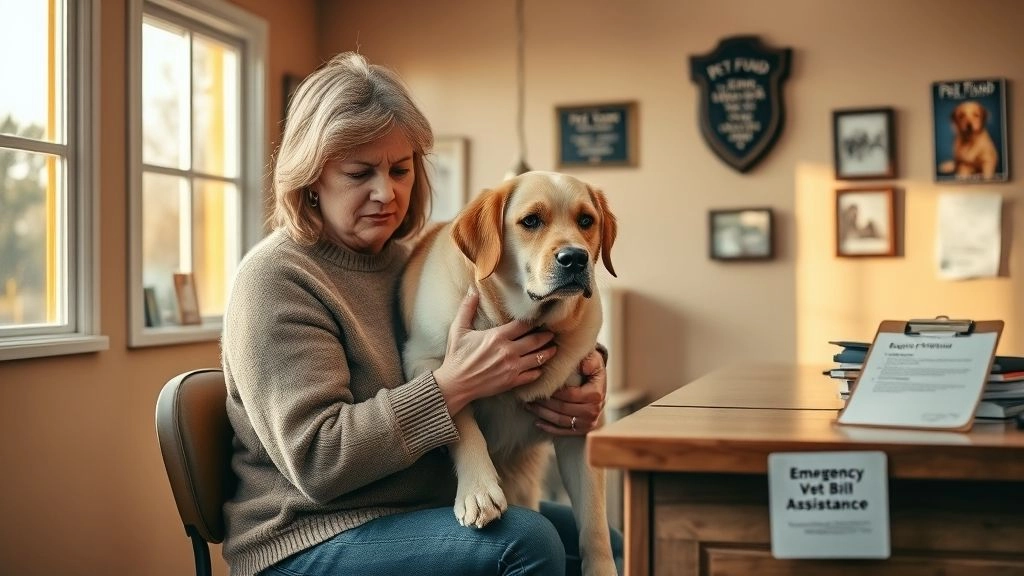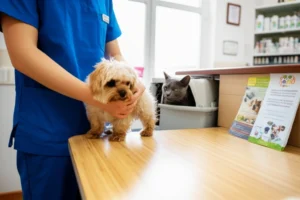Why Do Vet Bills Hurt So Much?
Let’s get real for a sec. You ever had that moment—crunching numbers, already skipping your beloved takeout once (okay, maybe twice) a week—when your furry buddy starts limping or making that weird noise and you just know: “Yep, I’m on a collision course with a vet bill.” It’s like your paycheque evaporated before it hit your account. And you’re sitting there, thinking, “Do people budget for this? Does anyone have an emergency envelope labeled ‘Dog Swallowed a Lego—Again’?”
That pit in your stomach is actually a warning sign… one too many frugal folks ignore (myself included, until my tabby Momo needed eye surgery and I nearly fainted at the invoice). If you relate—welcome, friend. This is for you.
Real Numbers, Real Stress
Pet emergencies are like surprise pop quizzes but instead of test scores, it’s big, scary numbers. In Canada, a single midnight emergency vet visit for a dog can run $1,000–$3,000 just to walk in the door. Surgeries and diagnostics? Many times more. Your wallet trembles. Your brain starts Googling all the ways to save money on vet bills—but have you ever stumbled on actual, honest-to-goodness grants to help with vet bills?
If not, keep reading. I promise, it’s not all GoFundMe and crossed fingers.
Where Are These Grants, Anyway?
Who’s Got Your Back?
This part is kind of a hidden treasure hunt. There really are organizations whose entire purpose is to keep you from having to choose between groceries and surgery for your pet. Some, like The Pet Fund, are staples of frugal living circles for exactly this reason.
But… the help’s not always where you expect. Sometimes, it’s in your own backyard—or accessed through your vet with a quick form and some basic paperwork.
Farley Foundation: The Quiet Hero
If you’re living in Ontario and money’s tight, the Farley Foundation genuinely wants to save your bacon. No, really—they’ve been running since 2002, giving out over $7 million to help low-income families keep their pets healthy. You don’t apply on your own; your vet applies for you, often with very little red tape compared to some government programs.
How do they choose? It’s not just first come, first served. They prioritize genuine need: folks on disability, seniors, people coping with serious illness, even women and families fleeing violence (through partner programs like SafePet Ontario). Their focus is on urgent, medically necessary care. No cosmetic stuff, only the real-deal emergencies and procedures that are truly make-or-break for your little furball.[source]
What’s Covered?
| Service | Example | Amount Covered | Frugal Tip |
|---|---|---|---|
| Surgery & emergencies | Foreign object removal | Up to $500/year, per clinic | Pair with monthly pet savings—more safety net |
| Diagnostics (lab, x-ray) | Bloodwork, scans | Fully or partially covered if funds available | Always ask if the clinic is a Farley Foundation partner |
| Medically necessary medications | Insulin, antibiotics | Partial support | Shop pharmacies for best prices after grant applied |
Example: Last winter, my friend Olivia barely scraped together rent after a sudden diagnosis left her dog, Bruce, needing expensive medicine. The Farley Foundation stepped in, paid the vet directly, and kept Bruce home, safe and healthy. Olivia? She cried, texted everyone she knew about it, and literally started a “pet savings jar.”
National Pet Care Fund: New on the Scene
This one’s a bit fresher but is already making noise among frugal pet parents. The National Pet Care Fund (NPCF) offers emergency vet bill assistance for urgent, non-elective cases. What’s cool? If your household is below the income cutoff, you can get up to $500 (half from the fund, half from the clinic in many cases). There’s paperwork, yes, but it’s miles easier than most government grant applications. Need to show some income info, fill out a form, that’s it.
If you’re sitting on the fence (“My pet’s healthy now… but what if?”), you can even pre-apply to be on their radar, so if disaster strikes you’re not scrambling. How’s that for proactive frugal living?
Other Secret Allies for Pet Parents
Local Programs & “Micro” Subsidies
Just about every major Canadian city has something—a whisper network of municipal charities, humane societies, or regional funds. In London, Kitchener, Hamilton, and the Brant area, PAWS Canada is the group you want. Their subsidies help prevent surrenders and can cover everything from wellness checks to urgent care and even spay/neuter clinics for those barely scraping by.
Their eligibility focuses on the “Low Income Cut-Off” (LICO)—or, let’s be honest, where most of us end up after one lost paycheque. If you’re in crisis, homeless, staying in a shelter, or even on student assistance and out on your own, they want to help. (Not sure if you qualify? Quick call or email—they’re friendly, trust me.)
emergency vet care for free programs can be literal lifesavers when you’re stuck between a rock and a thousand-dollar invoice.
Table: Typical LICO Guidelines
| Family Size | 12-Month Income | 6-Month Income |
|---|---|---|
| 1 person | $28,339 | $14,170 |
| 2 people | $35,282 | $17,641 |
| 3 people | $43,373 | $21,687 |
| 4 people | $52,662 | $26,331 |
Not in one of those cities? Call your local humane society, animal shelter, or even your city council—they know what’s up and can refer you. Sometimes, even 211 can point you to surprise sources you’d never uncover in a Google marathon.
How to Spot—and Grab—the Right Grant
It’s Not as Scary as You Think
Heads up: You don’t need to face mountains of paperwork in your darkest hour. Most grants to help with vet bills keep it human. Here’s what you’ll usually need:
- Proof of income (tax forms, paystubs, or social assistance papers)
- Diagnosis or treatment plan from your vet (get it in writing!)
- Fill out a quick form (yours or the vet’s; the vet often does this for you, hallelujah)
My tip? Don’t wait until it’s an absolute 3am emergency. If your pet’s got a chronic illness (think diabetes, kidney issues, or recurring skin stuff), chat with your vet now about possible grant sources. Early birds aren’t just catching worms—they’re dodging the full retail price of treatment, too.
Internal Links to Know
For even more ideas, click through these whenever you’re deep in a late-night panic spiral: emergency vet bill assistance, RSPCA help with vet bills, or The Pet Fund. Sometimes the best route is stacking resources—ask if one grant can supplement another.
How to Save Even More—Because, Duh, That’s Why You’re Here
Start with the Obvious: Preventive Care
I used to brush off vaccines and regular checkups as “extras”… until our neighbor’s unvaccinated dog caught parvo. Emergency care ended up costing triple what routine clinics charge. Some vet assistance programs (like PAWS or local clinics) discount basic stuff like vaccines, making it so much cheaper to stay on top of health than to play catch-up. It’s the dental floss rule: a little now, a lot saved later.
Budgeting in Tiny Bites (It Works!)
If you’re the spreadsheet type, you’ve probably got a “pet” category already. If not, hear me out: a jar, envelope, or digital savings bucket with just $10 a month. In a year, that’s $120—enough to cover a checkup, or at least soften a tough bill. After Olivia’s experience, she started this habit and jokes it’s her “anti-panic fund.” It’s small, but it’s powerful. Habit > magic number.
Insurance and Other Plan Bs
I used to think pet insurance was for rich people. Nope. Some plans run as little as $20/month, and if you have more than one disaster-prone critter, it really can add up in savings. Not into insurance? That’s cool—focus on grants, savings jars, and those “emergency vet care for free” clinics to build your frugal defense system.
Story Time: It’s Not Just About Money
You know those moments when your pet looks at you, and you just know you’d do anything to help them? That’s what these grants are about—minimizing the gut-wrenching finances, so you and your pet can focus on healing and love, not numbers.
A friend of mine rescued a senior cat last year—and three months later faced a $1,200 dental bill. She was devastated. I sent her the link for emergency vet bill assistance, and she wrote later, “I felt like someone saw us and understood. I didn’t have to give Kaylee up.” That feeling? Priceless. The relief, knowing there’s a way to care for the creatures who’ve stuck by you—through breakups, job loss, and the odd lasagna catastrophe?
Honestly… it’s what helps me keep believing in all this frugal, slightly-messy, big-hearted living. Maybe it’s the same for you, too.
What Now? Action, Not Panic
If you’re reading this, you’re already on the right track. Start your safety net now—make a call, bookmark a grant page, or ask your vet what resources you haven’t tapped yet. Each month you can tuck away a little for emergencies, and each time you check for programs like emergency vet bill assistance or revisit The Pet Fund when times get tough, you’re ahead of the game.
This isn’t foolproof—life rarely is, especially with pets. But every grant, every frugal trick is a kind of love letter: “I’ll take care of you, no matter what.”
Bring It Home (And Keep It Light)
Your pet is family. Money? Just a tool to keep that relationship strong. If your wallet’s looking more “sad trombone” than “winning lottery ticket,” remember—there are grants to help with vet bills. Whether it’s a crisis or just getting ahead of the curve, a little planning mixed with a lot of resourcefulness can turn a panic moment into a relief sigh.
So, if you feel that creeping anxiety or see the first twinge in your pup’s walk—don’t freeze, don’t drown in Google. Take a step. Call your vet. Look up The Pet Fund, or see if a program like RSPCA help with vet bills or emergency vet care for free fits your situation. Share this guide with a friend who needs a nudge, and build your pet’s safety net together. You’re not alone, not even close. Frugal doesn’t mean alone—it means smart, scrappy, and surrounded by unexpected kindness. And you, my friend, are right where you need to be.













